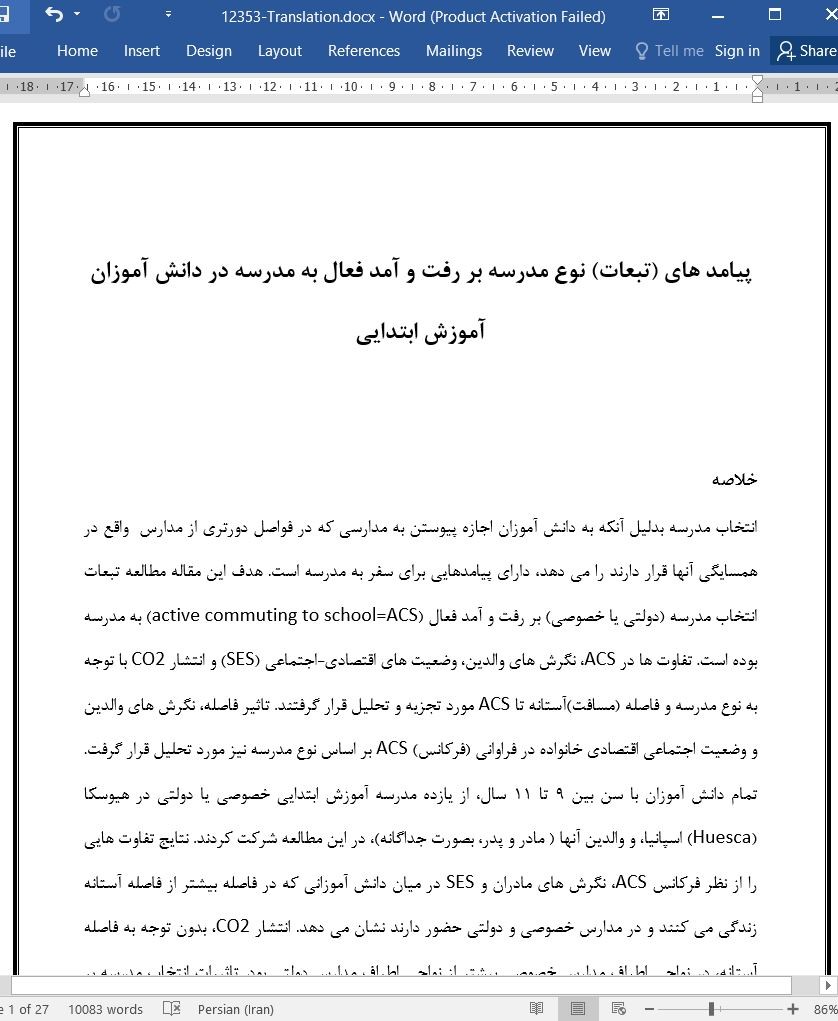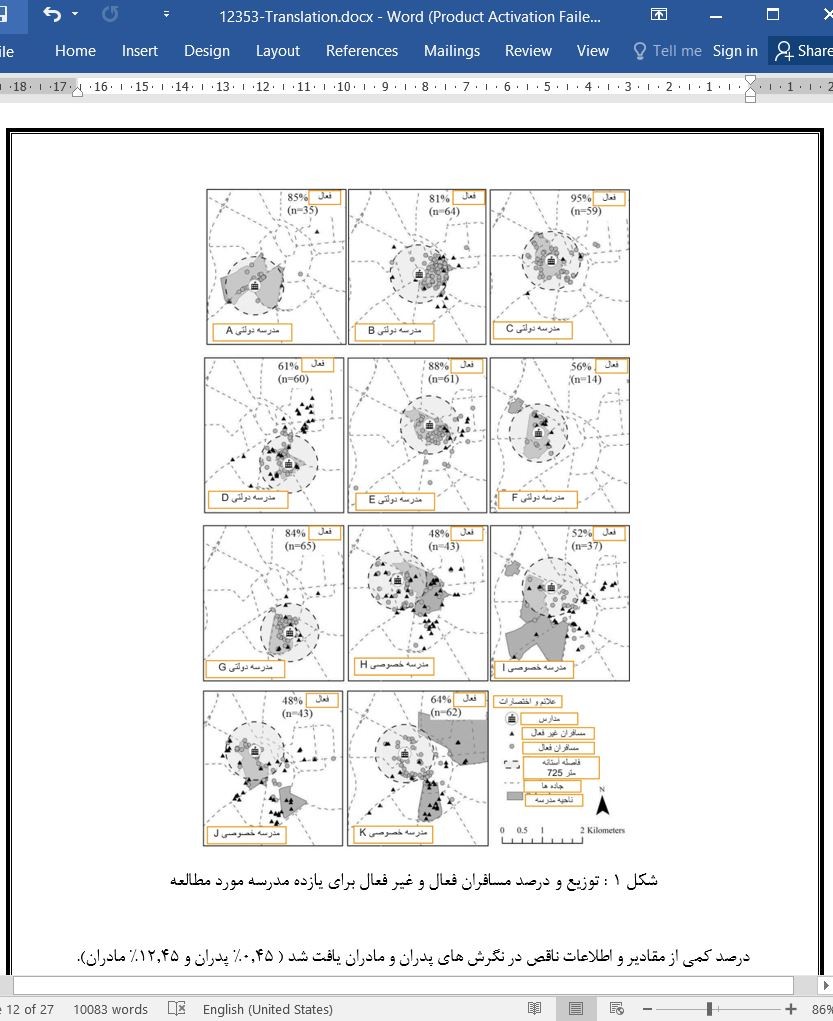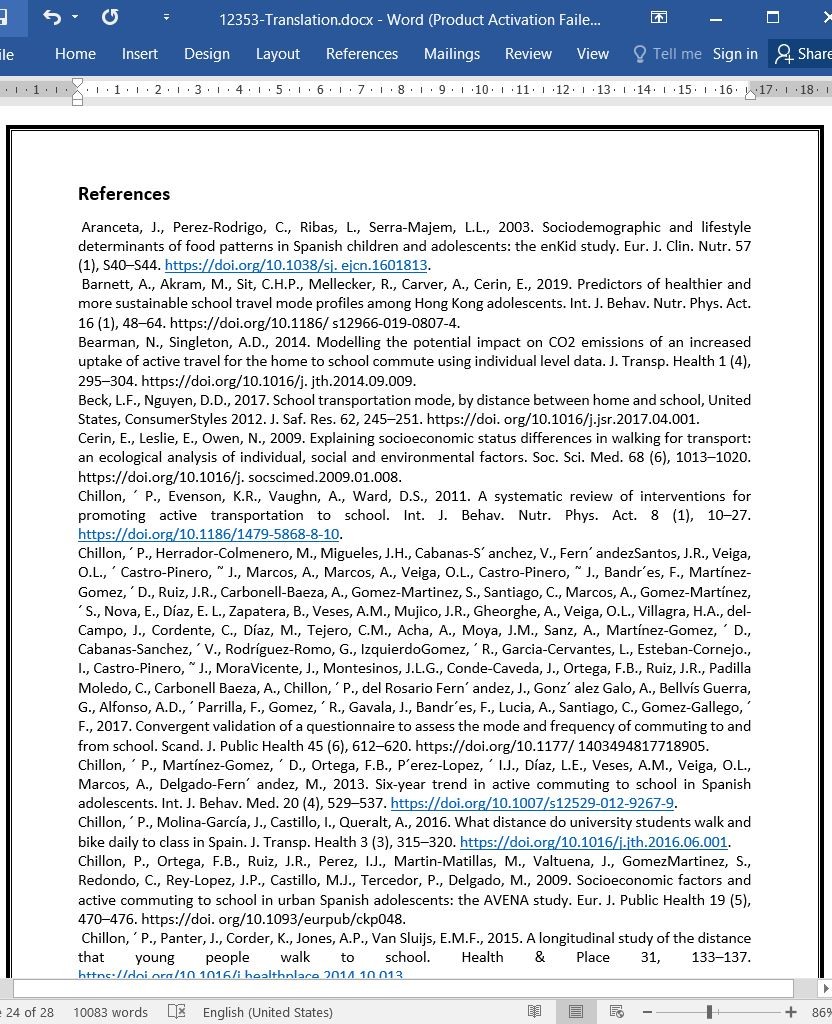
پیامدهای (تبعات) نوع مدرسه بر رفت و آمد فعال به مدرسه
خلاصه
انتخاب مدرسه بدلیل آنکه به دانش آموزان اجازه پیوستن به مدارسی که در فواصل دورتری از مدارس واقع در همسایگی آنها قرار دارند را می دهد، دارای پیامدهایی برای سفر به مدرسه است. هدف این مقاله مطالعه تبعات انتخاب مدرسه (دولتی یا خصوصی) بر رفت و آمد فعال (active commuting to school=ACS) به مدرسه بوده است. تفاوت ها در ACS، نگرش های والدین، وضعیت های اقتصادی-اجتماعی (SES) و انتشار CO2 با توجه به نوع مدرسه و فاصله (مسافت)آستانه تا ACS مورد تجزیه و تحلیل قرار گرفتند. تاثیر فاصله، نگرش های والدین و وضعیت اجتماعی اقتصادی خانواده در فراوانی (فرکانس) ACS بر اساس نوع مدرسه نیز مورد تحلیل قرار گرفت. تمام دانش آموزان با سن بین 9 تا 11 سال، از یازده مدرسه آموزش ابتدایی خصوصی یا دولتی در هیوسکا (Huesca) اسپانیا، و والدین آنها ( مادر و پدر، بصورت جداگانه)، در این مطالعه شرکت کردند. نتایج تفاوت هایی را از نظر فرکانس ACS، نگرش های مادران و SES در میان دانش آموزانی که در فاصله بیشتر از فاصله آستانه زندگی می کنند و در مدارس خصوصی و دولتی حضور دارند نشان می دهد. انتشار CO2، بدون توجه به فاصله آستانه، در نواحی اطراف مدارس خصوصی بیشتر از نواحی اطراف مدارس دولتی بود. تاثیرات انتخاب مدرسه بر فرکانس هفته ای رفتار ACS در دانش آموزان حاضر در مدارس دولتی به نظر می رسد که بطور عمده توسط ارتباط آن با مسافت رفت و آمد، SES و نگرش های مادران توضیح داده می شود. در حالی که، در مورد مدارس خصوصی، مدل نهایی تاثیر فاصله، نگرش های مادران و جنسیت را بر فرکانس هفته ای ACS نشان داد. این مقاله نشان می دهد که چگونه انتخاب مدرسه می تواند مد رفت و آمد به مدرسه و برخی متغیر هایی مرتبط دیگر از جمله فاصله، نگرش های مادران و انتشار CO2 را تحت تاثیر قرار دهد.
1. معرفی
بیش از 80 درصد جمعیت کشور های اروپایی انتظار می رود که تا سال 2030 در نواحی شهری زندگی کنند (اتحادیه اروپا، 2016). مشخصه و ویژگی الگوی رشد شهر های اروپایی گسترش و توسعه در نواحی حاشیه ای (Jaraiz-Cabanillas et al, 2018)، ایجاد تمرکز زدایی خدمات (مانند مدارس)، تغییر الگوی تحرک (Dombriz, 2009; Pozueta and Gurovich,2007)، افزایش استفاده از وسایل حمل و نقل خصوصی برای رفت و آمد به مدرسه (Ortuzar and Willumsen,2008) و در نتیجه، کاهش جابجایی های فعال مانند پیاده روی یا دوچرخه سواری (European Union,2019;Galvez-Fernandez et al,2020) می باشد. این اتکا به خودرو منجر به ایجاد تاثیرات منفی بر محیط زیست به روش های مختلف شده است. برای مثال، خودرو ها گاز های گلخانه ای از جمله کربن دی اکسید را منتشر می کنند که باعث تشدید گرمایش جهانی می شود (Van Ristell et al,2013). کاهش حمل و نقل فعال در الگوهای ACS مدرسه منجر به ایجاد نگرانی هایی در ارتباط با پیامد های محیط زیستی از جمله انتشار گاز های گلخانه ای، آلودگی آب و هوا و تراکم ترافیک شده است (Ewing,2003; Ewing et al, 2004).
Abstract
School choice has implications for school travel as it allows students to attend schools that are further away from their residence than their neighborhood schools. The aim was to study the implications of school choice (i.e., private or public) for active commuting to school (ACS). Differences on ACS, parental attitudes, socio-economic status (SES) and CO2 emissions with respect to the type of school and the threshold distance to ACS were analyzed. The influence of distance, parents' attitudes, and family socioeconomic status, in the frequency of ACS by type of school were also analyzed. All students aged 9 to 11 years old, from eleven public or private primary education schools in Huesca (Spain), and their parents (i.e., mother and father, separately), participated in this study. The results show differences among students, who live above the threshold distance and attend public and private schools, in terms of frequency of ACS, mothers’ attitudes, and SES. CO2 emissions were higher in the area around private schools than public schools, regardless of the threshold distance. Effects of school choice on weekly frequency of ACS behavior appear to be mostly explained by its connection with travel distance, SES and by mothers’ attitudes, in students attending public schools. While, for private schools, the final model showed an influence of distance, mother’s attitudes, and gender, on weekly frequency of ACS. This paper highlights how school choice can influence the mode of commuting to school, and some other related variables such as distance, mothers’ attitudes, and CO2 emissions.
1. Introduction
More than 80% of the European population are expected to live in urban areas by 2030 (European Union, 2016). The growth model of European cities has been characterized by an expansion into peripheral areas (Jaraiz-Cabanillas et al., 2018), creating a decentralization of services (e.g., schools), changing mobility patterns (Dombriz, 2009; Pozueta and Gurovich, 2007), increasing the use of private vehicles for school travel (Ortúzar and Willumsen, 2008) and, consequently, reducing active transportation, such as walking or cycling (European Union, 2019; Galvez-Fern ´ andez ´ et al., 2020). This car reliance has led to negative impacts on the environment in several ways. For example, cars emit greenhouse gasses, such as carbon dioxide, which contribute to global warming (Van Ristell et al., 2013). A reduction in active commuting to school (ACS) patterns, has led to concerns over such environmental consequences as greenhouse gas emission, air and water pollution, and traffic congestion (Ewing, 2003; Ewing et al, 2004). Moreover, car reliance causes traffic congestion around schools and adverse health impacts related to less physical activity (PA) levels (Faulkner et al., 2009). The World Health Organization (WHO, 2016), recommends urban planners to encourage PA through the design of urban spaces, and to promote active transportation as a serious alternative to motorized options.
خلاصه
1. معرفی
2.مواد و روش ها
2.1 تنظیمات، شرکت کنندگان و روش ها
2.2 مدل ناحیه بندی مدرسه
2.3 متغیر ها
2.4 متغیر های اجتماعی-جمعیت شناختی
2.4.1 شیوه معمول رفت و آمد و فرکانس ACS
2.4.2 وضعیت اقتصادی اجتماعی
2.4.3 نگرش های مادران و پدران
2.4.4 انتشار CO2 تخمین زده شده
2.4.5 تحلیل آماری
3 نتایج
4 بحث و گفتگو
5 نتیجه گیری ها
منابع
ABSTRACT
1. Introduction
2. Material and methods
2.1. Setting, participants and procedures
2.2. School zoning model
2.3. Variables
2.3.1. Sociodemographic variables.
2.3.2. Usual mode of commuting and ACS Frequency.
2.3.3. Socioeconomic status
2.3.4. Mother’s and Father’s attitudes
2.3.5. Estimated CO2 emissions
2.4. Statistical analysis
3. Results
4. Discussion
5. Conclusions
References
- اصل مقاله انگلیسی با فرمت ورد (word) با قابلیت ویرایش
- ترجمه فارسی مقاله با فرمت ورد (word) با قابلیت ویرایش، بدون آرم سایت ای ترجمه
- ترجمه فارسی مقاله با فرمت pdf، بدون آرم سایت ای ترجمه



